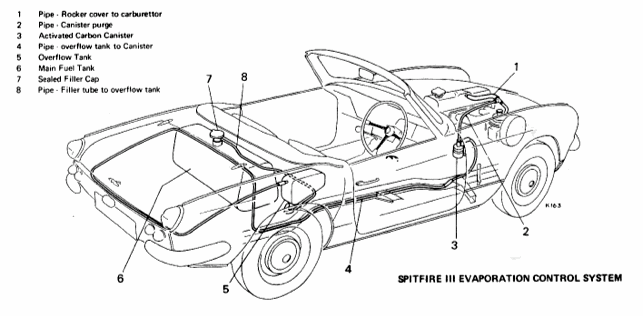The Newest Things in Emission Controls
California, leader among the US states in establishing controls over exhaust emissions, has now enforced a further ruling dealing with "evaporative emissions." Gasoline evaporates while the car is running or idling, through the fuel tank vent and other apertures, creating an additional air pollution hazard.
To combat this, a sealed vent system with a charcoal filter incorporated must be included on all new cars sold in California from January 1, 1970. Drivers of 1970 Triumphs will have this additional benefit all over the country. The system will become mandatory nationwide in 1971 and Triumph's engineers have put it on all TRs a year ahead.
Following is the official factory description of the system.
Evaporation Control System
Description
The evaporation control systems for the GT 6+, TR 6 and Spitfire MK III share the same design features differing only to accommodate the variations in vehicle layout.

Diagram: Triumph Evaporation Control System, 1970 Spitfire
The main principles and features of the system are as follows:
- The system is sealed except at one point where a canister of activated carbon is interposed between the system and atmosphere. When, in hot conditions, the fuel tank breathes out vapor the fuel content is retained in the activated carbon. When the engine is running, a pipe, from the canister to the constant depression area of the carburetor(s) is used to purge the activated carbon.
- An overflow tank, in the luggage compartment, allows for the expansion of fuel from a full main tank in hot conditions. The overflow pipe from the main tank is led from the topmost point of the fuel filler tube to the bottom of the overflow tank. The system venting also uses this circuit so that, before replacing used fuel with air, the contents of the overflow tank must first be drawn back into the main tank.
- The circuit used to replace used fuel with air in the main tank is via the connection-filler neck to bottom of overflow tank, top of overflow tank via piping to the activated carbon canister. Thus filtered air is drawn into the main fuel tank.
- The piping from the overflow tank to the activated carbon canister is routed round the luggage compartment. This ensures that, at any vehicle angle, i.e., subsequent to accident, etc., part of the piping circuit will be above the fuel tank thus minimizing the risk of fuel leaks to the canister.
- The top of the fuel filler tube is sealed by a specially designed, impact resistant, filler cap which ensures that the fuel system remains sealed in all conditions.
- The activated carbon canister incorporates a replaceable gauze filter which protects the carbon from possible breakdown due to the ingress of dirt and other road abrasives.
Servicing
Minimal servicing is required on the evaporation control system apart from changing the filter gauze in the carbon canister every 12,000 miles and replacing the canister every 48,000 miles.
















Want to leave a comment or ask the owner a question?
Sign in or register a new account — it's free